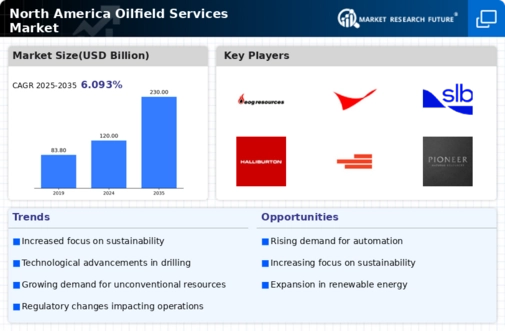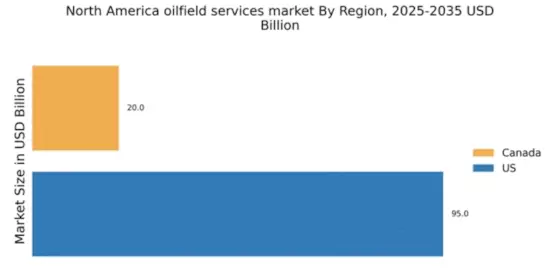Geopolitical Factors
Geopolitical factors play a significant role in shaping the oilfield services market. North America is influenced by global oil prices, trade policies, and international relations, which can impact domestic production levels. In 2025, fluctuations in oil prices due to geopolitical tensions could lead to increased volatility in the market. This uncertainty may drive oilfield services companies to adapt their strategies, focusing on cost efficiency and risk management. The oilfield services market must remain agile in response to these external pressures, potentially leading to innovations in service delivery and operational practices. Additionally, geopolitical developments may create opportunities for collaboration and partnerships, further influencing market dynamics.
Rising Energy Demand
The increasing energy demand in North America is a primary driver for the oilfield services market. As the population grows and industrial activities expand, the need for oil and gas resources intensifies. In 2025, North America is projected to consume approximately 25 million barrels of oil per day, which necessitates enhanced exploration and production activities. This surge in demand compels oilfield services companies to innovate and optimize their operations, thereby driving market growth. The oilfield services market is likely to benefit from this trend as companies invest in advanced technologies and efficient practices to meet the rising energy needs. Furthermore, the shift towards cleaner energy sources may also influence the types of services offered, as companies adapt to changing consumer preferences and regulatory frameworks.
Environmental Regulations
Environmental regulations are shaping the operational landscape of the oilfield services market. In North America, stringent regulations aimed at reducing carbon emissions and promoting sustainable practices are becoming more prevalent. By 2025, it is expected that compliance costs for oilfield services companies could rise by 15% due to these regulations. This scenario compels companies to adopt cleaner technologies and practices, thereby influencing service offerings. The oilfield services market must navigate these regulatory challenges while also capitalizing on opportunities to provide environmentally friendly solutions. As companies innovate to meet compliance standards, they may also discover new market segments focused on sustainability, which could lead to further growth.
Technological Integration
Technological integration within the oilfield services market is transforming operational efficiencies and service delivery. The adoption of advanced technologies such as artificial intelligence, big data analytics, and automation is becoming increasingly prevalent. In 2025, it is anticipated that over 30% of oilfield services companies in North America will implement AI-driven solutions to enhance decision-making processes. This trend indicates a shift towards data-driven strategies that optimize resource allocation and reduce costs. The oilfield services market is likely to experience significant advancements as companies leverage these technologies to improve safety, efficiency, and environmental compliance. Moreover, the integration of technology can facilitate real-time monitoring and predictive maintenance, which are essential for maximizing productivity.
Investment in Infrastructure
Investment in infrastructure is a crucial factor propelling the oilfield services market. North America has seen substantial capital allocation towards the development of pipelines, refineries, and processing facilities. In 2025, it is estimated that over $100 billion will be invested in oil and gas infrastructure projects across the region. This influx of capital not only enhances the operational capabilities of oilfield services but also creates a more robust supply chain. The oilfield services market stands to gain from these developments as companies are called upon to provide specialized services, including drilling, maintenance, and logistics. Additionally, improved infrastructure can lead to reduced operational costs and increased efficiency, further stimulating market growth.


















Leave a Comment